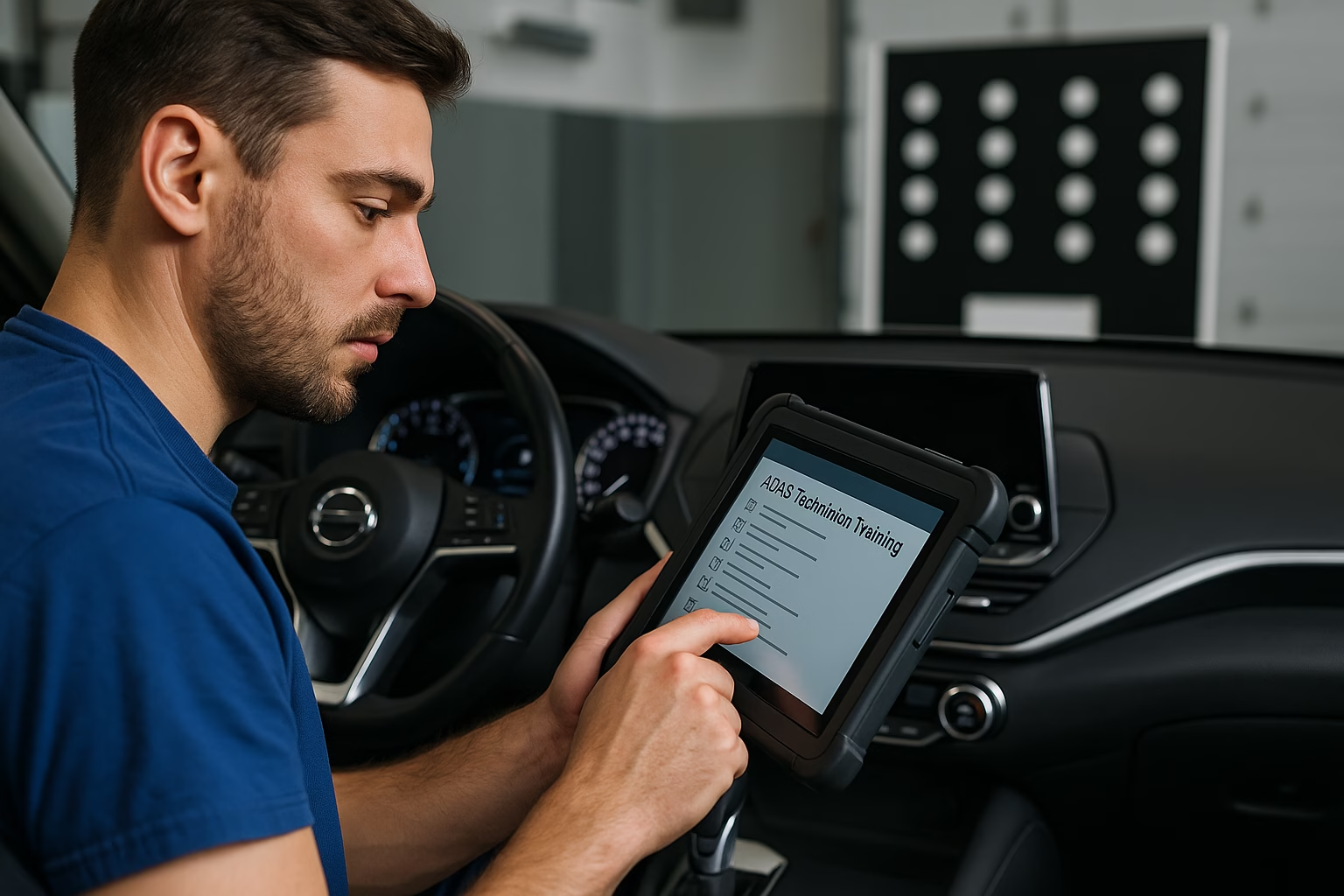As advanced driver assistance systems (ADAS) become mainstream, properly trained technicians are becoming essential. According to a 2020 survey cited by CarADAS, an estimated 92.7 per cent of new vehicles sold in 2018 were equipped with at least one ADAS feature and major automakers pledged to make automatic emergency braking standard by September 2022. These systems rely on cameras, radar and lidar sensors mounted in windscreens, bumpers and mirrors. Even a minor collision or windscreen replacement can knock them out of alignment, meaning features like lane keeping or adaptive cruise control may not function as intended. Because miscalibrated sensors can cause safety features to stop working or intervene unnecessarily, professional training and certification are crucial.
Why specialised training matters
Calibration isn’t as simple as bolting on a part. Sensors must be aligned to within millimetres using prescribed procedures, test patterns and diagnostic scan tools. Technicians must know when to carry out static calibration in a controlled workshop using targets and laser alignment tools, and when to use dynamic calibration that takes the vehicle out on the road at a prescribed speed. They need to understand how wheel alignment affects sensor aim, how different ADAS features operate, and how to interpret diagnostic trouble codes and software updates. Without the right knowledge and equipment, a repairer risks returning a vehicle with non‑functional safety systems and exposing themselves to liability.
Core skills for ADAS technicians
According to CarADAS’ training programme overview, an effective curriculum covers the following elements:
- Identifying equipped vehicles: Knowing which models and trim levels include ADAS features, recognising sensor housings and cameras, and checking manufacturer documentation.
- Calibration environment: Preparing a controlled, level area with uniform lighting and calibrated targets for static recalibration.
- Types of calibration: Understanding static versus dynamic methods, and when to choose each based on the feature being calibrated and manufacturer guidelines.
- Reading fault codes: Using scan tools to perform pre ‑ and post‑scans, read DTCs and clear codes after repairs.
- Alignment quick checks: Performing wheel and suspension alignment checks because misalignment can misdirect radar beams.
- Set‑up and verification: Positioning targets at correct distances, performing the calibration sequence, conducting test drives for dynamic calibrations, and verifying results with post‑scans.
- Troubleshooting: Diagnosing warning lights, software updates and sensor replacement issues, and understanding when to refer to specialist support.
Training pathways and certifications
The training landscape is evolving quickly. Many original equipment manufacturers (OEMs) now offer ADAS repair and calibration courses specific to their models. These programmes teach technicians to follow brand‑specific procedures and use proprietary equipment. Attending OEM courses can be essential when working on vehicles still under factory warranty.
Independent training providers and industry organisations have also developed comprehensive programmes. In Australia, CarADAS and I‑CAR run multi‑day courses covering the theoretical background and hands‑on calibration exercises. Equipment manufacturers such as Bosch, Texa and Autel host training sessions for the calibration rigs and scan tools they sell. These programmes often culminate in a certificate of completion that demonstrates competency to insurers and workshop managers.
Formal certification is still emerging, but industry bodies are starting to recognise the need for standard credentials. The US‑based National Institute for Automotive Service Excellence (ASE) has introduced an ADAS specialist certification, and I‑CAR’s continuing education programme now includes ADAS modules. In the future, we can expect regulators and insurers to require technicians to hold recognised ADAS qualifications before performing calibrations.
On‑the‑job learning and workshop readiness
Training doesn’t end in the classroom. To build confidence, technicians need supervised practice using calibration rigs, scan tools and alignment equipment. Workshops must invest in the right tools: calibration targets, radar reflectors, infrared panels, wheel alignment stands and reflective floor mats for static calibrations. They also need clear test routes for dynamic calibrations. Because technology evolves quickly, technicians should allocate time for ongoing training to keep up with new sensors, software updates and autonomous driving features.
Sensor fusion and higher levels of automation, the role of calibration technicians will only become more specialised. Future systems will rely on redundant inputs from cameras, radar and lidar, combined with artificial intelligence and vehicle‑to‑everything (V2X) communication. Keeping up with these advances will require a commitment to lifelong learning. Workshops that invest in training and certification will be better equipped to deliver safe, reliable repairs and build customer trust.
Conclusion
In the coming years, most vehicles will be fitted with advanced driver assistance features. Ensuring these systems work as intended requires skilled technicians who understand the underlying technologies and calibration procedures. By pursuing structured training programmes, staying current with manufacturer updates and obtaining recognised certifications, ADAS technicians can deliver quality work, reduce liability and support the road safety benefits these systems promise.

Hiran Alwis is an automotive lecturer and ADAS specialist with over 15 years of experience in diagnostics, advanced safety systems, and technical training. He founded ADAS Project to help everyday drivers and workshop technicians understand and safely use advanced driver assistance systems.
